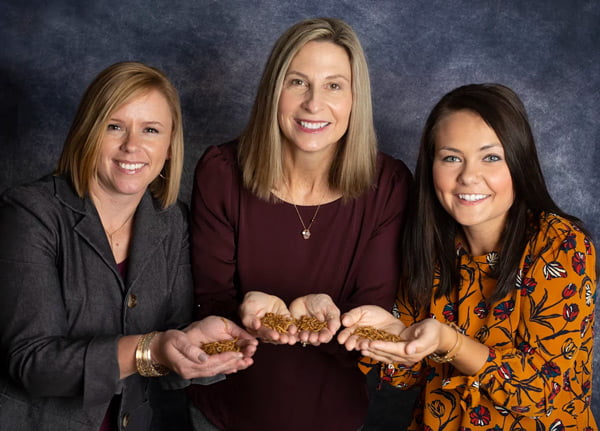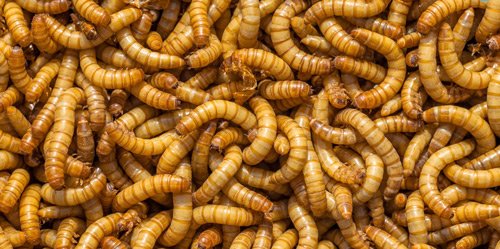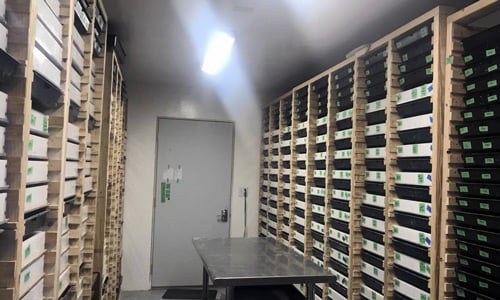Cheryl Powers ‘87 raises livestock that is like no other. Instead of grazing on verdant pastures, her six-legged creatures slither and crawl over each other in plastic trays, munching on wheat bran and potatoes. Unlike their doe-eyed, four-legged farmyard companions, her critters are cringe-worthy, not cute, and their “herds” number in the millions.
Though seeing one might make you go “eww,” the lowly mealworm is packed with protein and a viable food source for an overpopulated planet, said Powers, CEO of Jord Producers, a newly-launched, commercial mealworm farm operation located at sites in Juniata and Lindsay, Nebraska.

“The world’s population is going to reach 10 billion, and we’re going to have to be more creative in finding protein,” she said. “Dried mealworms are 55 percent protein. That’s pretty impressive. So is the environmental footprint of what it takes to raise them.”
For now, Powers and her co-founders, Kris Vrooman and Amber Klassen, are focused on selling live mealworms as a food source for animals.
“My passion is the food industry, but I recognize that there’s a cringe factor to mealworms. They’re not for everyone. So, the low hanging fruit is to sell them live to customers who use them to feed other animals,” Powers said.
Customer segments include bait shops, wild bird stores, zoos and owners of specialty pets like lizards, turtles, hedgehogs and tarantulas. Since chickens love mealworms (“They’ll do flips for them,” Powers said), the women are targeting backyard poultry owners and commercial poultry producers.
Calling themselves “entrepreneurial women who are not afraid to get our hands dirty,” Jord takes pride in shipping containers of product that arrive not only alive but thriving.
“We’re small enough to care what the customer thinks,” Powers said. “When we send the first shipment, I always follow up with a phone call to make sure they’re satisfied. We love it when they say the worms are beautiful.”
Mealworms through the life cycle

At Jord’s production sites in Juniata and Lindsay, hundreds of trays in vertical towers hold millions upon millions of eggs, larvae, pupae and adult darkling beetles, the entire lifecycle of the mealworm. Beetles are separated from the eggs since they eat their young.
The inch-long, yellow-skinned larvae (mealworms), which shed their exoskeletons 10 to 20 times in a lifecycle, are sold as tasty treats for animals in Nebraska and surrounding states. Even the insects’ manure, known as frass, is marketed as an odorless fertilizer for indoor and outdoor plants.
The breeding process, which takes place in climate-controlled barns, is relatively simple but time consuming with a three- to four-month span from egg to harvested mealworm.
“You have to keep a cycle going with breeding stock,” Powers said. “You can’t have all of your mealworms ready to harvest this week, because what would you have for next week? You have to keep populating so you consistently have a product.”
Powers, a member of the Hastings College Foundation Board of Trustees and former assistant director of admissions at Hastings College, became interested in the insect food industry after participating in start-up and business accelerator programs at the University of Arizona and University of Nebraska–Lincoln. After conducting interviews with 150 potential customers, she and her partners decided to launch the business in 2018.
“I wanted a company name that reflected my Danish heritage,” Powers said. “I Googled the word for Earth, since we’re dealing with a sustainable protein, and it came back ‘Jord’ [pronounced Yord] in Danish. In Norse mythology, it means goddess of the Earth, which seemed appropriate for an all-female business.”
The budding entrepreneurs faced a steep learning curve and a dearth of local resources in starting their venture. Unlike cattle, hog or poultry producers, they couldn’t turn to local veterinarians or county extension offices to learn best practices. When Powers approached a university entomologist, he told her, “I’d love to help you, but I work on eradicating, not growing, insects.”
So they watched YouTube videos, read articles and attended workshops on mealworm farming. In November, they attended Insectinov3 in Paris, an international conference where they’ll network with industrial-scale producers of insects for human and animal nutrition.
“Europe has been raising mealworms as an alternative protein much longer and at a much higher level than the U.S.,” Powers said. “They’re ahead of us by at least 10 to 15 years.”
An unlimited need for protein

As the women of Jord Producers ramp up their production capabilities, they’re also researching the equipment and permits necessary to dry and grind mealworms. The resulting protein-packed flour could be sold to companies for pet food and treats, replace some of the soy protein in poultry feed and, one day, provide an ingredient for human food like cakes, waffles or protein shakes.
Eating insects isn’t as unappetizing or unusual as it seems. At Seattle’s T-Mobile Park, home of the Mariners baseball team, the chapulines (toasted grasshoppers) are a hit with fans and a viral sensation. Chefs across the country are using insects in dishes like tacos, soup and sushi. And the insect protein market, including both human and animal nutrition, is projected to reach $1.3 billion by 2025 from $144 million in 2019, according to MarketsandMarkets, which tracks high-growth emerging markets worldwide.
Closer to home, alumni attending “Walk on the Wild Side,” an event co-sponsored by Jord Producers and Hastings College at Steeple Brewing Co. in downtown Hastings, munched on treats like cookies, chips and mac ‘n cheese balls made with insects. “The Southern fried crickets were especially tasty,” said Alicia O’Donnell ‘96, director of alumni engagement and annual giving.
Although widespread human consumption of Jord’s slithering product is at least a few years down the road, Powers is on a mission to share the virtues of her highly-sustainable, protein-packed food source. In time, she hopes to recruit a co-op of farmers to harvest mealworms for people and businesses throughout the region.
“Mealworms are self contained,” she said. “They don’t jump. They don’t fly. It makes them easy to raise.”
